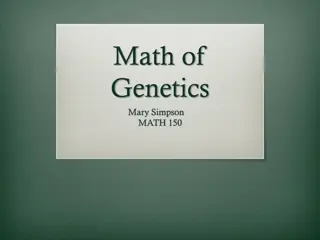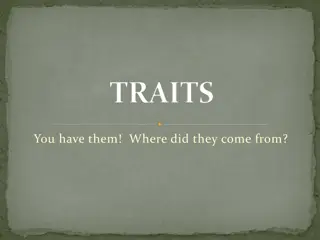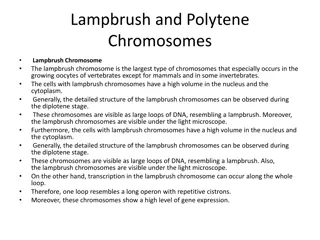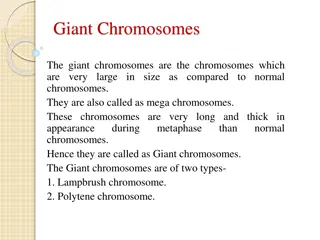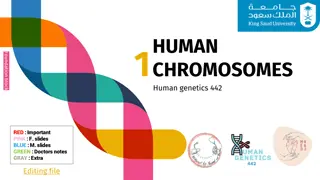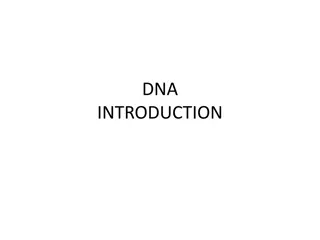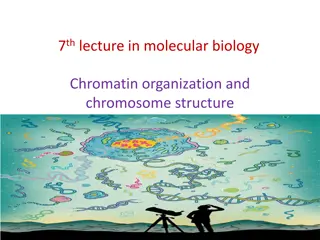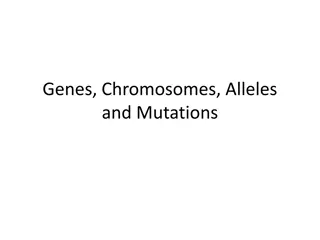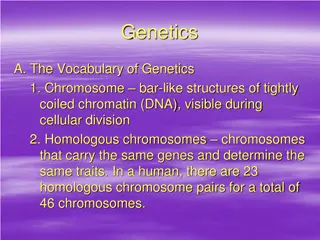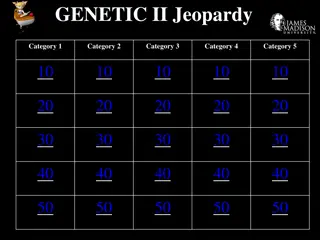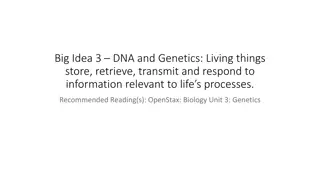Understanding Chromosomes, Genes, and DNA in Genetics
This educational material explores the fundamentals of chromosomes, genes, and DNA, highlighting how genetic material is inherited from parents, determining traits such as eye color, blood type, and more. It explains the relationship between chromosomes, genes, and DNA, emphasizing their importance in controlling various characteristics in humans. Additionally, it delves into sex chromosomes and how they determine an individual's gender.
Download Presentation

Please find below an Image/Link to download the presentation.
The content on the website is provided AS IS for your information and personal use only. It may not be sold, licensed, or shared on other websites without obtaining consent from the author. Download presentation by click this link. If you encounter any issues during the download, it is possible that the publisher has removed the file from their server.
E N D
Presentation Transcript
Chromosomes, genes and DNA By: Tala Dababneh
Jens Martensson Lesson overview In this lesson we will understand that organisms inherit characteristics from their parents through genetic material that is carried in cell nuclei 2
What are genes? Genes are set of instructions contained in the nucleus cell some genes are the same in everyone so we all have similar bodies , other genes help to make us all slightly different Your genes determine your traits, such as eye color and blood type DNA DNA is a molecule that carries all the genetic information (A short section of a DNA is a gene) Jens Martensson 3
Chromosomes A chromosome is a long thin thread that is made up of proteins and DNA (deoxyribonucleic acid) . Each cell normally contains 46 chromosomes arranged in 23 pairs . Jens Martensson 4
How are chromosomes, genes and DNA all linked to each other ? The long thin threads in the cell nuclei are the chromosomes. They are made from a giant molecule which is the DNA scattered along each chromosome are special section of DNA are the genes cell Chromosome DNA Jens Martensson Gene 5
Characteristics A human cells have 23 pairs because we inherit 23 chromosomes from each parent so we inherit half of each parent s genes and two copies of each gene and also take different characteristics that are transmitted from parents to offspring Characteristics controlled by genes Characteristics controlled by the environment Language and accent spoken Body mass Height Intelligence Jens Martensson Blood group Body mass Height Intelligence 6
Sex chromosomes every human has two forms of chromosomes called X and Y Sex chromosome carry the genes that decide whether you are a female or male. Females have two X chromosomes and males have an X and Y chromosome. Jens Martensson 7
Why do parents are equally likely to have a boy or girl ? A fertilized egg cell could get two X chromosomes and produce a girl, or get an X and a Y chromosome and produce a boy. The diagram shows that the chances of producing a boy is a 50% chance and a chance to get a girl is also a 50% chance Jens Martensson 8
What decides the gender the fertilized egg grows into? Jens Martensson Males can make two sorts of sex cells. On average, half a mans sperm carry X chromosomes and have carry Y chromosomes, so the sperm cell decides the gender. 9
Dominant and recessive genes The terms dominant and recessive describe the inheritance patterns of certain traits. That is, they describe how likely it is for a certain phenotype to pass from parent offspring. Dominant genes Recessive genes A gene that has no affect when only on copy of the recessive gene is present A gene that always affects an organism even when only one copy of the dominant gene is present Jens Martensson Genotype an organism's complete set of genes. It is the heritery information ex. BB or Bb Phenotype The set of observable characteristics of an individual resulting from the interaction of its genotype with the environment. 10
Q1. T/F The nucleus of every cell contains 23 chromosome Jens Martensson False, they contain 46 chromosomes 11
Q2 Explain why you have two copies of every gene Jens Martensson The genes on paired chromosomes do the same jobs as each other, so we inherit two copies of each gene one from each parent 12
Q3 What is the genotype of a person with two dominant alleles for long eye lashes Jens Martensson LL 13
Thank You


